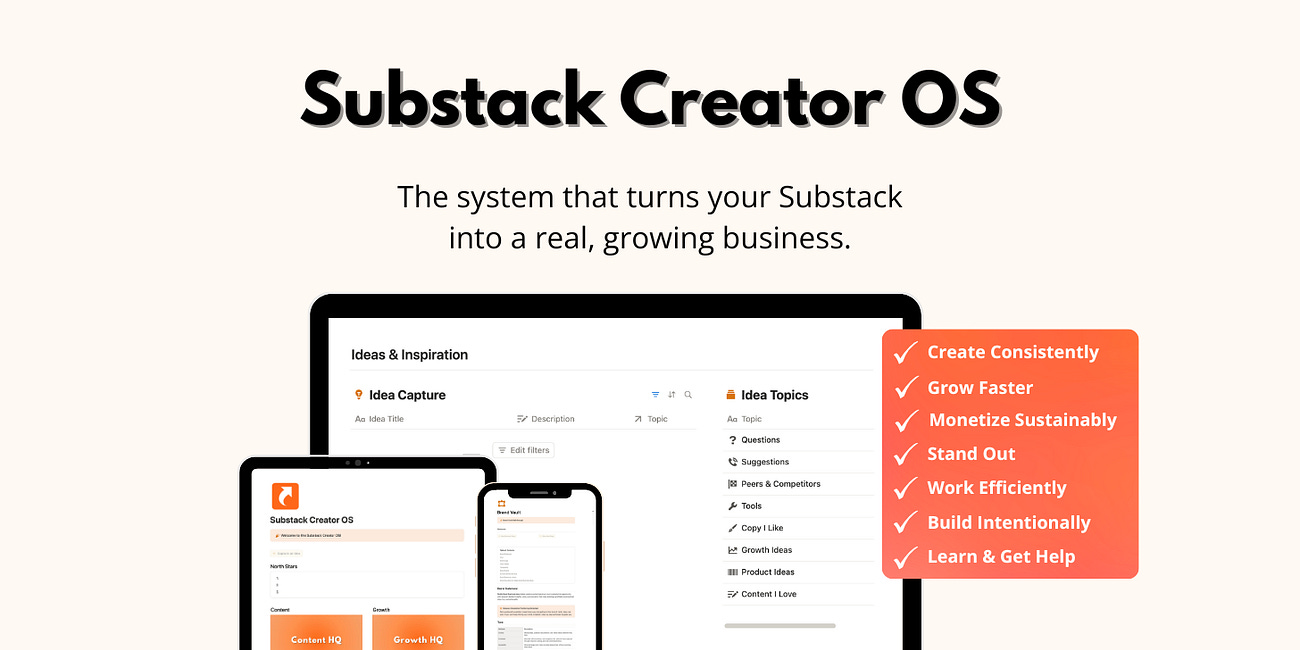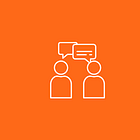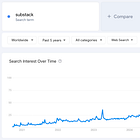What Is the Typical Paid Subscriber Conversion Rate on Substack?
An analysis based on real publication data.
✨ New: The Substack Creator OS is here!
A complete Notion workspace for running and growing your Substack like a pro.
Publish more consistently with a streamlined content pipeline that eliminates chaos and guesswork.
Grow faster by turning your ideas, posts, and outreach into a clear, trackable growth system.
Increase your revenue with built-in tools for managing sponsors, products, and your paid subscriber strategy.
Right now, it’s free for Premium subscribers.
Have you ever wondered how many paid subscribers other publications are converting?
Substack claims that 5–10% of total subscribers is normal.1
“We tend to see 5-10% of free subscribers convert to paying subscriptions, with 10% being a rate to aim for. If your conversion rate is significantly below 10%, use tried-and-true tactics from other writers to improve it.”
I find this hard to believe.
So far, I have only seen two reports of a 10% paid subscriber conversion rate; both were from small publications.23
I suspect there are publications with very high paid conversion rates, but they are likely outliers with unique circumstances.
Why? Substack keeps making it easier for publications to grow free subscribers with new growth features and network effects. But the easier they come, the lower their intent.
What is Reader Intent?
Intent describes how motivated or engaged a reader is. If I am highly interested in what you create and it’s timely for me, I will have a very high intent. I will be very engaged, likely reading all your articles, commenting, and telling others about it. And I will be motivated to upgrade my subscription to get behind the paywall.
But if I’m only somewhat interested in your content, or it’s not timely for me, I’ll have a lower intent. I might only occasionally read articles, I might not like or comment very often, and I may not see enough value in paying for gated content.
Substack’s growth features are more likely to grow your low-intent readers than high-intent readers.
Let’s look at three features that drive network effects on Substack to understand this.
1. Substack Accounts
Once a reader has subscribed to a publication and created their account on Substack, it’s much easier for them to subscribe to new publications. If they’re logged into their account, their email address will already populate the form and all they have to do is click “Subscribe.”
But someone who only subscribed to your Substack because they already have an account has lower intent than someone who took the time to find you and write out their email address.
2. Recommendations
Many authors on Substack use the Recommendations feature to share other publications they love or as part of a collaboration between them. When readers subscribe to a publication on Substack, they will see a list of recommended publications that they can also subscribe to with one click.
But someone who only subscribed because they clicked yes to the recommendations that surfaced after subscribing to another newsletter has lower intent than someone who searched Google and found that your publication provided the answer they were looking for.
3. Notes
Substack has its own social media network called Notes. When a user sees a Note they like, instead of following the person who wrote it, they can easily click “Subscribe” directly in the feed without even looking at that person’s publication(s).
Someone who subscribes from the Notes feed has less intent than someone who reads something you posted on Reddit, navigates to your Reddit profile, clicks the link to your publication, and then subscribes.
All these growth features on Substack can help publications grow by removing friction from subscribing, but they also lower average reader intent over time.
These growth features are still useful; we wouldn’t acquire many of our subscribers without them. While they are less likely to become paid subscribers, some will, just at a lower rate than high-intent readers.
These features don’t decrease the motivation of high-intent subscribers; they just add more lower-intent subscribers to the pool. So, your average paid subscriber conversion rate will go down, but your total paid subscribers keep growing.
What Is The Typical Paid Subscriber Conversion Rate?
For the past while, every time I have found a report that shares a publication’s total and paid subscribers, I have added it to a spreadsheet.
Here’s an example from Russell Nohelty who is always very generous about sharing a behind-the-scenes look at his publication.
Using Notes, articles, Reddit posts, and more, I’ve found dozens of reports covering the past five years from publications with less than 100 total subscribers to publications with tens of thousands of total subscribers.
This data shows that the median paid subscriber conversion rate is 3%.
My findings also match those of a writer at Journalists Pay Themselves, who said the journalists they spoke to claimed to have paid subscriber conversion rates between 2–5%.4
In my data, only 20% of publications have a conversion rate higher than 5%, which makes Substack’s claim of a 5–10% average very unlikely.
Can You Help Grow This Dataset?
The more reports we have, the more reliable this data becomes. It also allows for more detailed analysis, such as by category or publication size.
If you’re willing to share your total subscribers and paid subscribers, I’d love to include them. We can keep your publication anonymous if you prefer. In exchange, I’ll share the dataset with anyone who submits their data (even if you’re not a Really Good Business Ideas Premium subscriber).
To add your data to the set, simply send me a direct message with a screenshot from your dashboard and let me know if you want to keep your publication anonymous.
To endless possibilities,
Casandra
Paid Subscriber Conversion Dataset
As always, the dataset I created is available to Premium subscribers who want to use it for their own analysis. I’ll continue to update it with new submissions as they come in. Anonymous submissions will obviously not include the publication name.





